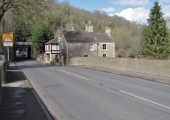Stokeford Bridge
.
Limpley Stoke and Winsley, Bradford on Avon, Wiltshire
.

As a route to Bath, horses could cross the Avon at the ancient Stoke Ford, at the foot of Winsley Hill and there must have been traffic between Stoke and its mother parish of Bradford.
In 1731 Thomas Dike of Limpley Stoke and Moses Cottle sr of Winsley, who owned the land on their respective sides, agreed to build a bridge over the Avon. Stokeford Bridge was in existence by 1739.
Originally it was a wooden structure, then the four piers with cutwaters were built and connected by a wooden deck. The stone arches between the piers were added later, after 1870. It was widened in 1930 and again to its present width in 1964 (Wiltshire County Architect G.R. Chadwick), carrying the busy B3108 road.
1752 first Road Act for Bradford: from [Monkton] Combe Bridge to Winsley via Stokeford Bridge to Bradford
1777 Act (17 Geo. III cap. 98): renewed the Act of 1752, adding the upkeep of Stokeford Bridge.
The bridge may have a Grade II listing, but it is also listed as a Scheduled Monument, but probably based on the misapprehension that it is of medieval origin.
 An old print shows the bridge when timber platforms connected the stone piers in the early part of the 19th century. The tollhouse is shown on the Limpley Stoke side of the river.
An old print shows the bridge when timber platforms connected the stone piers in the early part of the 19th century. The tollhouse is shown on the Limpley Stoke side of the river.
.
.
.
 Tolls for using the bridge and for using the road from Combe Bridge to Bradford were collected from the house on the Limpley Stoke (western) side, now called Bridge Cottage.
Tolls for using the bridge and for using the road from Combe Bridge to Bradford were collected from the house on the Limpley Stoke (western) side, now called Bridge Cottage.
.
.
.
 A similar view in a late nineteenth century photograph, with the bridge much narrower than it is today. Beyond it is the original wooden railway bridge erected by the Wilts Somerset & Weymouth Railway in 1857.
A similar view in a late nineteenth century photograph, with the bridge much narrower than it is today. Beyond it is the original wooden railway bridge erected by the Wilts Somerset & Weymouth Railway in 1857.
.
.

